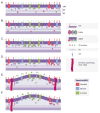Protein selection and export via outer membrane vesicles
- PMID: 24370777
- PMCID: PMC4317292
- DOI: 10.1016/j.bbamcr.2013.12.011
Protein selection and export via outer membrane vesicles
Abstract
Outer membrane vesicles (OMVs) are constitutively produced by all Gram-negative bacteria. OMVs form when buds from the outer membrane (OM) of cells encapsulate periplasmic material and pinch off from the OM to form spheroid particles approximately 10 to 300nm in diameter. OMVs accomplish a diversity of functional roles yet the OMV's utility is ultimately determined by its unique composition. Inclusion into OMVs may impart a variety of benefits to the protein cargo, including: protection from proteolytic degradation, enhancement of long-distance delivery, specificity in host-cell targeting, modulation of the immune response, coordinated secretion with other bacterial effectors, and/or exposure to a unique function-promoting environment. Many enriched OMV-associated components are virulence factors, aiding in host cell destruction, immune system evasion, host cell invasion, or antibiotic resistance. Although the mechanistic details of how proteins become enriched as OMV cargo remain elusive, recent data on OM biogenesis and relationships between LPS structure and OMV-cargo inclusion rates shed light on potential models for OM organization and consequent OMV budding. In this review, mechanisms based on pre-existing OM microdomains are proposed to explain how cargo may experience differing levels of enrichment in OMVs and degrees of association with OMVs during extracellular export. This article is part of a Special Issue entitled: Protein trafficking and secretion in bacteria. Guest Editors: Anastassios Economou and Ross Dalbey.
Keywords: Bacterial envelope; Cargo selection; Gram-negative bacteria; Outer membrane vesicle; Secretion.
Copyright © 2014 Elsevier B.V. All rights reserved.
Figures

References
-
- Mayrand D, Grenier D. Biological activities of outer membrane vesicles. Can J Microbiol. 1989;35:607–613. - PubMed
-
- Kadurugamuwa JL, Beveridge TJ. Natural release of virulence factors in membrane vesicles by Pseudomonas aeruginosa and the effect of aminoglycoside antibiotics on their release. J Antimicrob Chemother. 1997;40:615–621. - PubMed
-
- Kuehn MJ, Kesty NC. Bacterial outer membrane vesicles and the host-pathogen interaction. Genes and Development. 2005;19:2645–2655. - PubMed
Publication types
MeSH terms
Substances
Grants and funding
LinkOut - more resources
Full Text Sources
Other Literature Sources

